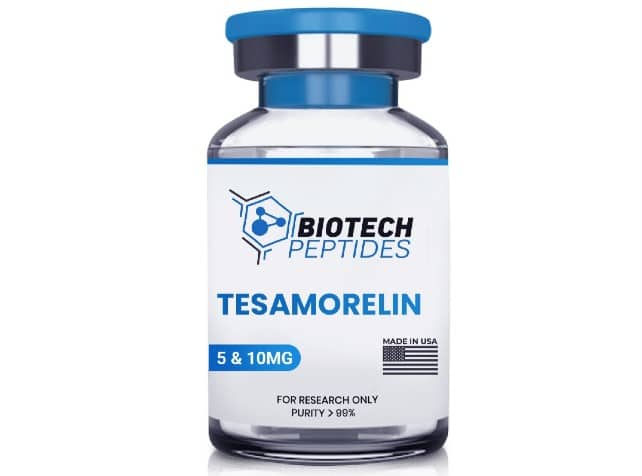Tesamorelin, a synthetic peptide analog of growth hormone-releasing hormone (GHRH), has recently garnered attention for its unique biochemical properties and intriguing impact on various physiological processes. Composed of a sequence of 44 amino acids, Tesamorelin is believed to selectively bind to GHRH receptors, potentially stimulating the pituitary gland to produce and secrete growth hormone (GH).
This interaction places Tesamorelin in a position of interest within scientific research, as growth hormone is a critical factor in cellular growth, metabolism, and tissue maintenance. In particular, the peptide’s hypothesized potential to modulate GH dynamics offers a valuable foundation for exploring its implications across numerous scientific disciplines, from endocrinology to regenerative biology.
Mechanism of Action and Biochemical Profile
Tesamorelin’s molecular structure is thought to allow it to interact with GHRH receptors in a way that may mimic endogenous GHRH more closely than other synthetic analogs. Research indicates that the peptide may stimulate a targeted response from the pituitary gland, prompting an increase in GH levels.
The subsequent rise in GH might initiate a series of downstream reactions, including the production of insulin-like growth factor 1 (IGF-1), a protein crucial for cellular proliferation, differentiation, and metabolic regulation. It is theorized that this potential to modulate GH and IGF-1 dynamics potentially gives Tesamorelin its distinctive biological impact.
Furthermore, Tesamorelin’s unique molecular design makes it relatively resistant to enzymatic degradation, which may help prolong its active period. This characteristic, coupled with its selectivity for GHRH receptors, suggests that Tesamorelin might act as a potent tool for temporally controlled GH stimulation.
Researchers are keen to investigate how these features might facilitate implications in scientific contexts where modulating GH and IGF-1 dynamics holds potential—ranging from cellular regeneration studies to investigations into metabolic function and cellular aging.
Potential Research Implications in Cellular Studies
One area of interest is cellular regeneration, where Tesamorelin’s speculative impact on GH and IGF-1 synthesis may hold promise. GH and IGF-1 have both been associated with cellular repair and tissue remodeling. Consequently, researchers are investigating whether Tesamorelin might influence pathways involved in cell renewal, particularly in tissues with limited regenerative capacity.
For example, some preliminary studies suggest that GH may support fibroblast proliferation and collagen synthesis, processes integral to skin cells and connective tissue resilience. It is hypothesized that Tesamorelin might have implications for further understanding these cellular mechanisms.
Theorized Impact on Metabolic Processes

Tesamorelin’s alleged involvement in GH stimulation opens up interesting possibilities for understanding metabolism at the molecular level. Research indicates that GH influences lipid metabolism, including lipid breakdown, fatty acid oxidation, and adipocyte differentiation.
This connection suggests that Tesamorelin might offer a unique model for studying the complex regulation of lipid storage and breakdown, essential components of metabolic integrity. Specifically, by manipulating GH levels, scientists may be able to examine how lipid redistribution may be influenced and what underlying mechanisms might govern this process.
Studies on Cellular Aging and Senescence
The peptide’s hypothesized potential to stimulate GH and subsequently increase IGF-1 levels has opened avenues for investigating cellular aging processes and cellular senescence. Cellular aging is marked by a progressive decline in regenerative capacity and metabolic efficiency, which is thought to be partly influenced by shifts in GH and IGF-1 levels.
Studies suggest that by increasing GH output, Tesamorelin might enable researchers to explore how shifts in endocrine signaling might impact cellular lifespan and functionality in different tissues.
Investigating Skeletal and Muscle Cell Physiology
Another potential research implication for Tesamorelin is believed to lie in its theoretical impact on skeletal and muscle cell physiology. Growth hormone is an unrestricted regulator of bone density and muscular tissue integrity. Some investigations have suggested that GH may support osteoblast activity, promoting bone formation and mineralization.
Researchers are curious whether Tesamorelin might offer insights into GH’s role in bone integrity, especially in the context of bone turnover rates and density regulation.
Prospects in Cognitive Integrity and Brain Science Research
Emerging data points to potential links between GH dynamics and cognitive function, leading scientists to hypothesize that Tesamorelin might offer a model for research into cognitive science and cellular aging that impacts the brain. GH and IGF-1 are both implicated in neuroplasticity and brain function, suggesting that Tesamorelin’s stimulation of GH might influence pathways associated with memory, learning, and neural adaptability.
Conclusion
The unique properties of Tesamorelin peptide position it as a promising candidate for diverse research implications, particularly due to its hypothesized impact on GH and IGF-1 regulation.
By potentially modulating GH dynamics, Tesamorelin opens doors to investigations across numerous scientific domains, from cellular regeneration and metabolic studies to cellular aging research and neurobiology.
These potential implications in scientific settings may enable a more detailed understanding of the molecular mechanisms underlying growth, metabolism, and tissue maintenance. Researchers can buy peptides online. None of the compounds discussed in this paper have been approved for consumption. This article serves educational purposes only.











